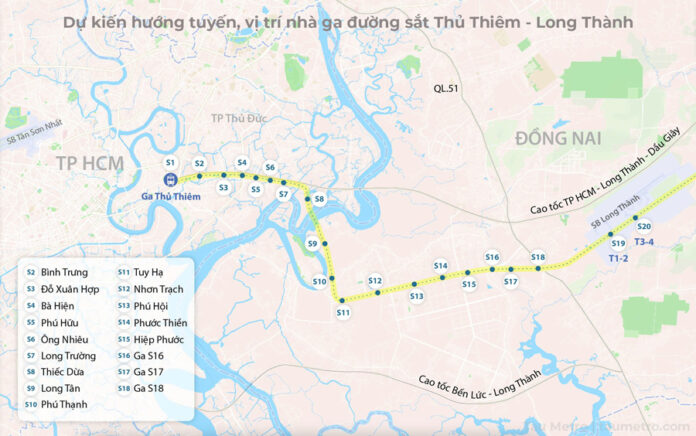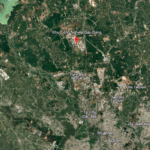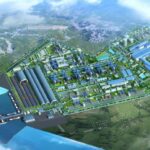The Thu Thiem-Long Thanh railway line, a crucial link in the region’s transportation network, is set to undergo significant development. With a length of approximately 42km and an estimated investment of around $3.5 billion, this project is currently under preparation by the Ministry of Construction. The project is expected to be submitted to the National Assembly for investment approval in October 2025.
As the Long Thanh airport gears up for operation, the Thu Thiem-Long Thanh railway plays a pivotal role in the region’s infrastructure plans. The project is being expedited to ensure timely connectivity to the airport. Experts emphasize the urgency of establishing convenient transportation links to the airport, and Ho Chi Minh City is poised to benefit from multiple connectivity options, including the Ho Chi Minh City-Long Thanh-Dau Giay expressway, the national railway system, and the upcoming Thu Thiem-Long Thanh urban railway.

Proposed station locations along the Thu Thiem-Long Thanh railway line.
In a recent development, the 27th session of the Dong Nai Provincial People’s Council approved Resolution No. 28, agreeing to assign the Ho Chi Minh City People’s Committee as the implementing agency for the Thu Thiem-Long Thanh urban railway project. This decision aims to expedite the project and ensure synchronization in construction, operation, and exploitation, enhancing overall efficiency.
Ho Chi Minh City’s plans include three railway routes serving the Tan Son Nhat and Long Thanh airports: the metro line 2, metro line 6, and the Thu Thiem-Long Thanh railway. Metro line 2 will connect Tan Son Nhat airport to Thu Thiem station, from where passengers can continue to Long Thanh airport via the Thu Thiem-Long Thanh railway.
Metro line 6 will link Tan Son Nhat airport to the Thu Thiem-Long Thanh railway (at Phu Huu junction), utilizing the shared infrastructure of the Thu Thiem-Long Thanh railway to connect to Long Thanh airport. Both metro line 6 and metro line 2 are under the management of the Ho Chi Minh City People’s Committee for investment.
The Thu Thiem-Long Thanh railway, with a starting point at Thu Thiem station in An Phu ward, Thu Duc city, Ho Chi Minh City, and an endpoint at the S20-Long Thanh station in the Long Thanh International Airport (T3 and T4 terminals), is designed as a double-track railway for intra-city and suburban passenger transport between Ho Chi Minh City, Dong Nai province, and Long Thanh airport.
Along the route, 20 stations are planned, with 12 stations in Dong Nai province (including 8 elevated and 4 underground stations) and the remaining 8 stations in Ho Chi Minh City. The elevated stations in Dong Nai are proposed to be built in Long Tan, Phu Thanh, Tuy Ha, Nhon Trach, Phu Hoi, Phuoc Thien, Hiep Phuoc, and Long An.
The four underground stations include S17 and S18 in Long Phuoc, S19-Long Thanh T1-2 in Binh Son, and S20-Long Thanh T3-4 at the Long Thanh International Airport in Binh Son.

The Thu Thiem-Long Thanh railway, with a designed speed of 120 km/h, will play a crucial role in connecting Ho Chi Minh City to the Long Thanh International Airport. Illustration.
Upon completion, the railway will provide a much-needed alternative to road transport, reducing congestion and improving travel times between Ho Chi Minh City and the Long Thanh airport to approximately 20 minutes. This will have a positive impact on the region’s economy, attracting investments, boosting tourism, and enhancing logistics services. The project is expected to stimulate economic growth, including a positive impact on the real estate market.
Real estate projects in close proximity to this transportation hub are already anticipating increased demand. For example, the FIATO Airport City apartment project by Thang Long Real Group, located just a 10-minute drive from Long Thanh airport, will benefit from improved accessibility once the Thu Thiem-Long Thanh light rail becomes operational. In anticipation of the railway project, the developer has been actively promoting the project through the opening of show flats and hosting weekend events to attract potential buyers.
Similarly, the SpringVille Nhon Trach project, a nearly 40-hectare development, is strategically timing its market entry to coincide with the region’s infrastructure advancements. Developers of projects along this transportation corridor frequently highlight upcoming infrastructure improvements, such as the imminent completion of the Nhon Trach Bridge, the expansion of the Ho Chi Minh City-Long Thanh-Dau Giay expressway to 10 lanes, and, of course, the construction of the Thu Thiem-Long Thanh railway.
The implementation of the Thu Thiem-Long Thanh railway will directly benefit real estate projects near the stations, fostering the development of high-end urban areas and commercial complexes. This, in turn, will drive up investment values and stimulate actual housing demand. The project is of strategic importance in the national transportation infrastructure development strategy and is expected to bring about positive changes, improving the lives of locals and boosting socio-economic development.
In addition to reducing travel time between Ho Chi Minh City and the Long Thanh International Airport, the railway will significantly alleviate traffic congestion on existing roads, particularly the overloaded Long Thanh-Dau Giay expressway. Passengers and locals will benefit from a safe, fast, and convenient means of transportation to and from the airport, without the worry of traffic jams. The project will also promote the development of satellite cities and contribute to reducing pollution and improving the overall quality of life in the region.
Notably, the Thu Thiem-Long Thanh railway will serve as a crucial catalyst for investment attraction. By directly linking the financial center of Thu Thiem to the Long Thanh International Airport, the railway will not only boost commercial and tourism activities but also facilitate the establishment of new economic centers and industrial parks along the corridor.

Real estate projects surrounding the Thu Thiem-Long Thanh railway are proactively preparing for the infrastructure development. Illustration.
According to Dr. Vo Kim Cuong, former Deputy Chief Architect of Ho Chi Minh City, the effective utilization and synchronization of urban railway routes like Thu Thiem-Long Thanh will provide a substantial and feasible boost to the region’s transportation network. This is not just about improving air connectivity but also about implementing a comprehensive transportation development strategy for the expanded Ho Chi Minh City metropolitan area. Therefore, establishing convenient transportation links to the Long Thanh airport is imperative but should be approached with careful consideration and integrated into a comprehensive transportation master plan.
Mr. Khuong Van Muoi, former Chairman of the Ho Chi Minh City Association of Architects, emphasizes the need to expedite the progress of the Thu Thiem-Long Thanh railway project. He asserts that modern transportation hubs, including bus terminals and ports, must be efficiently connected to enhance mobility and trade. Similarly, airports should be seamlessly integrated to facilitate the smooth flow of people and goods. Metro systems should not be limited to single lines but designed as strategic transportation networks, connecting Long Thanh with the entire Ho Chi Minh City expanded region, including both the central areas and satellite cities.
- 2022-2024: Preparation of pre-feasibility study reports. Submission of pre-feasibility study reports to the Ministry of Transport for internal appraisal in Q4/2024.
- Q1/2025: Finalization of pre-feasibility study reports and submission to the State Appraisal Council.
- Q2/2025: Submission of pre-feasibility study reports to the National Assembly for investment approval.
- Q1/2026: Completion of feasibility study reports and submission for project approval.
- Q2/2026: Commencement of site clearance and compensation.
- Q4/2026: Completion of EPC contractor selection and project commencement.
- Q4/2026 to 2029: Construction and equipment procurement phase.
- 2030: Expected trial operation and commercial operation.
Essensia Parkway – Immaculate Legalities, Sustainable Growth
Essensia Parkway offers more than just a place to call home today; it is a sound investment for future generations. With meticulous attention to detail in its planning and legalities, this development stands as an exemplary model of modern living.
A once-expansive industrial zone, quadrupling the size of Hoan Kiem District, is set to receive a further investment boost of VND 3,500 billion for its upcoming 1,000-hectare expansion.
The Bau Bang Industrial Park is set to become a massive industrial hub, spanning an impressive 3,000 hectares upon completion.
What Do Business Insiders Say About Allowing Used Car Trading Through VNeID?
The Ministry of Public Security has initiated a pilot program for transferring ownership of used vehicles through its online public service portal in Ho Chi Minh City. This innovative initiative simplifies the process of changing ownership for pre-owned vehicles, offering a seamless and efficient experience to citizens.





















